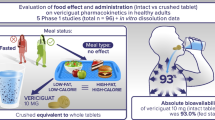Abstract
Purpose. The purpose of this study was to use a replicate designed trial to assess the overall, intra- and inter-subject variabilities in pharmacokinetic parameters of CGP 33101 after oral administration of tablets relative to that of powder suspended in water, and to determine the relative proportion of the intra-subject variance to the overall variability.
Methods. Sixteen healthy subjects were randomly assigned to four groups to receive tablets and suspension twice in four different treatment sequences. The plasma concentration-time profile of CGP 33101 was characterized in terms of Cmax, Tmax, and AUC. Bioavailability of tablets relative to suspension and intra- and inter-subject variability were assessed by statistical analysis.
Results and Conclusions. The overall variabilities in absorption kinetics of CGP 33101 in healthy subjects were small with CV's of the population mean values for AUC and Cmax less than 26% for both tablets and suspension. Contribution of intra-subject variability to the overall variability was also small (~20%). Both the overall and intra-subject variabilities of AUC and Cmax after suspension were larger than after the tablets. However, the differences in variability between tablets and suspension were not statistically significant (p > 0.05). The tablet formulation was bioequivalent to suspension in terms of rate and extent of absorption based on 90% conventional confidence intervals (for AUC and Cmax) and Wilcoxon rank-sum test (for Tmax).
Similar content being viewed by others
REFERENCES
C. M. Metzler and D. C. Huang. Statistical methods for bioavailability and bioequivalence. Clin. Res. Practices & Drug Reg. Affairs 1(2):109–132 (1983).
M. Rowland. Intra-individual variability in pharmacokinetics. In D. D. Breimer (ed.), Towards Better Safety of Drugs and Pharmaceutical Products. Proceedings of the 39th International Congress of Pharmaceutical Sciences of F.I.P., held in Brighton, U.K., September 3–7, 1979, Elsevier/North-Holland Biomedical Press, Amsterdam, New York, Oxford, 1980, pp. 143–151.
R. A. Dederich, S. J. Szefler, and E. R. Green. Intrasubject variation in sustained-release theophylline absorption. J. Allergy Clin. Immunol. 67(6):465–471 (1981).
A. Yacobi, R. G. Stoll, G. C. Chao, R. A. Schwartz, D. J. Weidler, J. W. Ayers, E. Sakmar, M. Hallmark, and J. G. Wagner. The assessment of the intra-subject variability in digoxin absorption in man from two oral dosage forms. J. Clin. Pharmacol. 21:301–310 (1981).
A. Grahnén, M. Hammarlund, and T. Lundqvist. Implications of intraindividual variability in bioavailability studies of furosemide. Eur. J. Clin. Pharmacol. 27:595–602 (1984).
G. M. Kochak, R. A. Smith, R. L. Choi, V. John, V. Tipnis, F. Honc, J. K. deSilva, and D. Weidler. Intra-and intersubject variability: Mixed-effects statistical analysis of repeated doses of an angiotensin converting enzyme inhibitor, CGS 16617. Pharma. Res. 6:328–331 (1989).
L. B. Sheiner, B. Rosenberg, and V. V. Marathe. Estimation of population characteristics of pharmacokinetic parameters from routine clinical data. J. Pharmacokin. Biopharm. 5:445–480 (1977).
H. H. Blume and K. K. Midha. Bio-international 92, conference on bioavailability, bioequivalence, and pharmacokinetic studies. J. Pharma. Sci. 82(11):1186–1189 (1993).
B. E. Rodda and R. L. Davis. Determining the probability of an important difference in bioavailability. Clin. Pharmacol. Ther. 28:247–252 (1980).
S.E. Smith and M.D. Rawlins. Variability in Human Drug Response, Butterworths, London, 1973.
M. M. Reidenberg. Symposium on individualization of drug therapy. Med. Clin. North Amer. 58:905–1159 (1974).
G. Alvan. Individual differences in the disposition of drugs metabolised in the body. Clin. Pharmacokin. 3:155–175 (1978).
S.C. Chow and J.P. Liu. Design and Analysis of Bioavailability and the Bioequivalence Studies, Marcel Dekker Inc, New York, 1992.
L. Brunner and M. Powell. An automated method for the determination of a new potential antiepileptic agent (CGP 33101) in human plasma using high performance liquid chromatography. Biomed. Chromatog. 6:278–282 (1992).
G. Koch. The use of nonparametric methods in the statistical analysis of the two-period change-over design. Biometrics. 28: 577–584 (1972).
E. Pitman. A Note on Normal Correlation. Biometrika. 31: 9–12 (1939).
N. Morgan. A Test for the Significance of the Difference Between the Two Variances in a Sample for a Bivariate Population. Biometrika. 31: 13–19 (1939).
M. McAlary. A macro to perform the Pitman-Morgan test accounting for period and sequence effects in 2×2 crossover trials. Paper presented at PharmaSUG Meeting, October 26–27, 1992, San Diego, CA.
Rights and permissions
About this article
Cite this article
Cheung, W.K., Kianifard, F., Wong, A. et al. Intra- and Inter-Subject Variabilities of CGP 33101 after Replicate Single Oral Doses of Two 200-mg Tablets and 400-mg Suspension. Pharm Res 12, 1878–1882 (1995). https://doi.org/10.1023/A:1016275402723
Issue Date:
DOI: https://doi.org/10.1023/A:1016275402723




